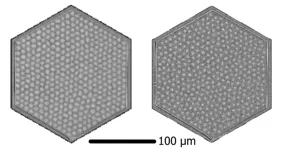Home > Press > First real-time observation of two-dimensional melting process: Researchers at Mainz University unveil new insights into magnetic vortex structures
 |
| Snapshots of the skyrmion lattice during the melting: an ordered skyrmion lattice on the left while the lattice structure has vanished on the right.
Credit photo/: Raphael Gruber |
Abstract:
What occurs during the melting process in two-dimensional systems at the microscopic level? Researchers at Johannes Gutenberg University Mainz (JGU) have explored this phenomenon in thin magnetic layers. “By utilizing skyrmions, i.e., miniature magnetic vortices, we were able to directly observe, for the first time, the transition of a two-dimensional ordered lattice structure into a disordered state at the microscopic level in real time,” explained Raphael Gruber, who conducted the research within the working group of Professor Mathias Klui at the JGU Institute of Physics. The findings, published in Nature Nanotechnology, are fundamental to a deeper understanding of melting processes in two dimensions and the behavior of skyrmions, which may revolutionize future data storage technologies.
First real-time observation of two-dimensional melting process: Researchers at Mainz University unveil new insights into magnetic vortex structures
Mainz, Germany | Posted on August 8th, 2025
Two-step melting of skyrmion lattices
While the concept of ice melting into water is familiar to most from a macroscopic perspective, the microscopic aspects of melting processes remain surprisingly poorly understood. “This phase transition is particularly intriguing in two-dimensional systems, where distinct phenomena emerge, differing from those observed in three-dimensional counterparts,” elaborated Gruber. Initially, the researchers generated skyrmions, which are magnetic vortex structures analogous to microscopic hurricanes, by precisely calibrating temperature and magnetic fields. Owing to their remarkable stability, skyrmions can be regarded as individual entities. When densely packed, these magnetic vortices self-organize into a regular lattice structure. “Our primary question was: What happens when we revert this ordered state to a disordered one in effect, when we melt the system?,” said Gruber.
Employing a magneto-optical Kerr microscope, the researchers observed this process in real time for the first time. In contrast to three-dimensional lattice structures, such as ice, the two-dimensional skyrmion lattice melts in a distinctive two-step process. During the initial step, translational order is lost, with individual skyrmions remaining within a lattice, yet exhibiting irregular distances to their nearest neighbors. Only in the subsequent step is the orientation also compromised, culminating in the complete dissolution of the lattice a melting process. “The elucidation of this melting transition was greatly facilitated by our collaboration with colleagues from the Center for Quantum Spintronics at the Norwegian University of Science and Technology,” noted Professor Mathias Klui.
Magnetic-field-induced melting: a novel approach
A distinctive aspect of this experimental design lies in the method used to induce melting. Typically, one would increase temperature. However, this approach is suboptimal in this context, as it would alter the conditions giving rise to the magnetic vortices. “Instead, we reduced the size of the skyrmions by modulating the magnetic field. This approach afforded the skyrmions greater mobility within the lattice, enabling movement,” explained Gruber. “This strategy, akin to increasing temperature, leads to the lattice structure becoming progressively disordered, ultimately resulting in its complete dissolution.” These findings pave the way for the potential application of skyrmions in future data storage technologies, offering significantly enhanced data density, rapid read/write access, and exceptional energy efficiency.
“This groundbreaking work was supported by the ERC Synergy Grant 3D MAGiC and, notably, by the TopDyn Center for Dynamics and Topology research initiative, funded by the Rhineland-Palatinate Research Initiative. Topology and the dynamics of topological properties represent a central research focus for numerous scientists in Mainz, with this study contributing to a growing body of exciting publications in this field,” said Klui, Director of TopDyn.
####
For more information, please click here
Contacts:
Media Contact
Kathrin Voigt
Johannes Gutenberg University Mainz
Office: +49 6131 39-27008
Expert Contact
Professor Dr. Mathias Klui
Johannes Gutenberg University Mainz — Institute of Physics
Copyright © Johannes Gutenberg University Mainz
If you have a comment, please Contact us.
Issuers of news releases, not 7th Wave, Inc. or Nanotechnology Now, are solely responsible for the accuracy of the content.
News and information
![]()
Sensors innovations for smart lithium-based batteries: advancements, opportunities, and potential challenges August 8th, 2025
![]()
Deciphering local microstrain-induced optimization of asymmetric Fe single atomic sites for efficient oxygen reduction August 8th, 2025
![]()
Lab to industry: InSe wafer-scale breakthrough for future electronics August 8th, 2025
2 Dimensional Materials
![]()
ICFO researchers overcome long-standing bottleneck in single photon detection with twisted 2D materials August 8th, 2025
![]()
Lab to industry: InSe wafer-scale breakthrough for future electronics August 8th, 2025
Imaging
![]()
ICFO researchers overcome long-standing bottleneck in single photon detection with twisted 2D materials August 8th, 2025
![]()
Simple algorithm paired with standard imaging tool could predict failure in lithium metal batteries August 8th, 2025
Magnetism/Magnons
![]()
Magnetism in new exotic material opens the way for robust quantum computers June 4th, 2025
![]()
Ultrafast plasmon-enhanced magnetic bit switching at the nanoscale April 25th, 2025
Skyrmions
![]()
Scientists use heat to create transformations between skyrmions and antiskyrmions January 12th, 2024
![]()
Spin photonics to move forward with new anapole probe November 4th, 2022
![]()
The ICN2 co-leads a roadmap on quantum materials September 29th, 2020
Possible Futures
![]()
ICFO researchers overcome long-standing bottleneck in single photon detection with twisted 2D materials August 8th, 2025
![]()
New molecular technology targets tumors and simultaneously silences two undruggable cancer genes August 8th, 2025
![]()
Simple algorithm paired with standard imaging tool could predict failure in lithium metal batteries August 8th, 2025
![]()
Lab to industry: InSe wafer-scale breakthrough for future electronics August 8th, 2025
Memory Technology
![]()
Utilizing palladium for addressing contact issues of buried oxide thin film transistors April 5th, 2024
![]()
Interdisciplinary: Rice team tackles the future of semiconductors Multiferroics could be the key to ultralow-energy computing October 6th, 2023
![]()
Researchers discover materials exhibiting huge magnetoresistance June 9th, 2023
Discoveries
![]()
Deciphering local microstrain-induced optimization of asymmetric Fe single atomic sites for efficient oxygen reduction August 8th, 2025
![]()
ICFO researchers overcome long-standing bottleneck in single photon detection with twisted 2D materials August 8th, 2025
![]()
New molecular technology targets tumors and simultaneously silences two undruggable cancer genes August 8th, 2025
![]()
Simple algorithm paired with standard imaging tool could predict failure in lithium metal batteries August 8th, 2025
Materials/Metamaterials/Magnetoresistance
![]()
Researchers unveil a groundbreaking clay-based solution to capture carbon dioxide and combat climate change June 6th, 2025
![]()
A 1960s idea inspires NBI researchers to study hitherto inaccessible quantum states June 6th, 2025
![]()
Institute for Nanoscience hosts annual proposal planning meeting May 16th, 2025
Announcements
![]()
Sensors innovations for smart lithium-based batteries: advancements, opportunities, and potential challenges August 8th, 2025
![]()
Deciphering local microstrain-induced optimization of asymmetric Fe single atomic sites for efficient oxygen reduction August 8th, 2025
![]()
Japan launches fully domestically produced quantum computer: Expo visitors to experience quantum computing firsthand August 8th, 2025
![]()
ICFO researchers overcome long-standing bottleneck in single photon detection with twisted 2D materials August 8th, 2025
Interviews/Book Reviews/Essays/Reports/Podcasts/Journals/White papers/Posters
![]()
New molecular technology targets tumors and simultaneously silences two undruggable cancer genes August 8th, 2025
![]()
Simple algorithm paired with standard imaging tool could predict failure in lithium metal batteries August 8th, 2025
![]()
Lab to industry: InSe wafer-scale breakthrough for future electronics August 8th, 2025
![]()
New imaging approach transforms study of bacterial biofilms August 8th, 2025










